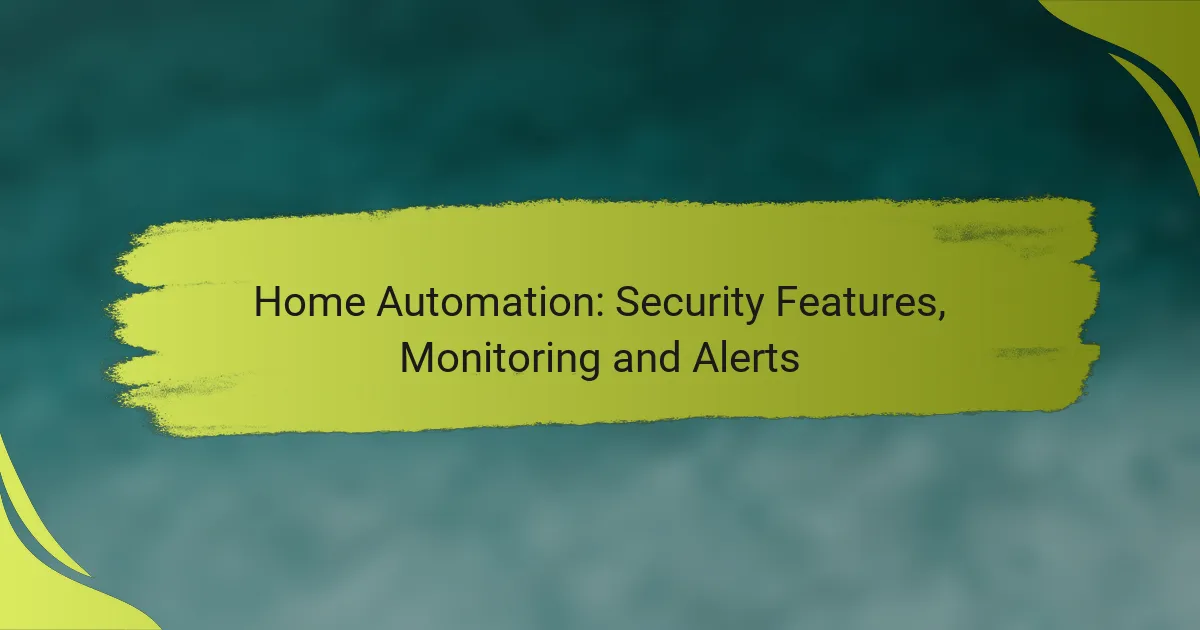Home automation offers advanced security features that significantly enhance the safety of your home. With smart locks, surveillance cameras, and motion sensors, homeowners can enjoy real-time monitoring and alerts, providing peace of mind. These interconnected systems allow for remote access and instant notifications, ensuring you are always informed about your property’s status.
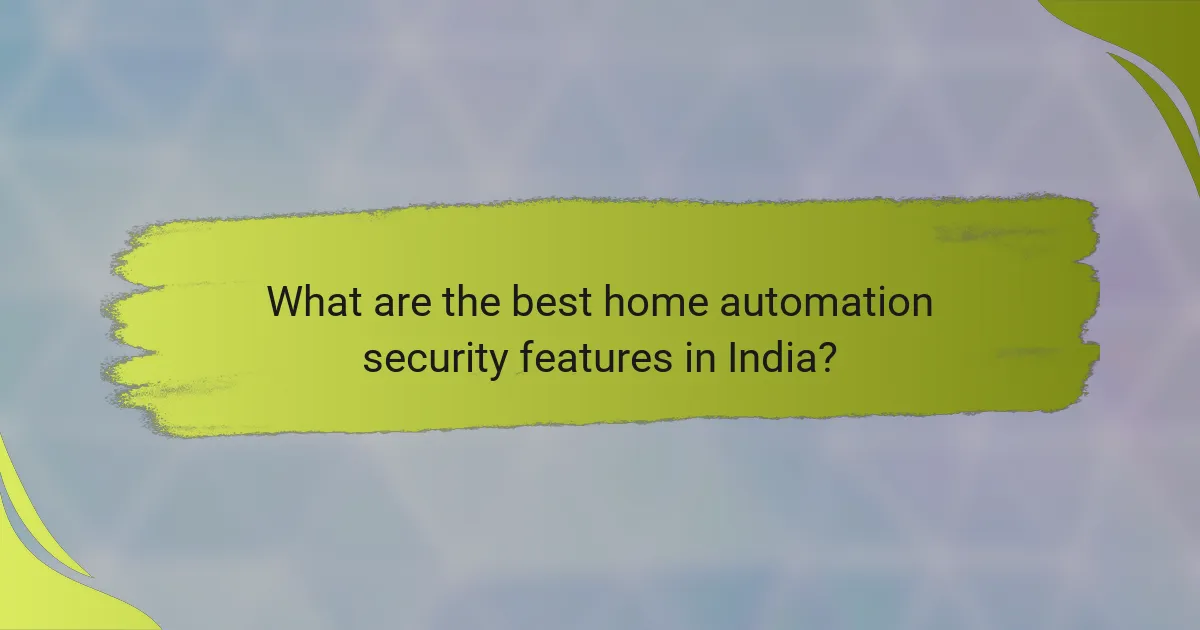
What are the best home automation security features in India?
The best home automation security features in India include smart locks, surveillance cameras, motion sensors, alarm systems, and video doorbells. These technologies enhance home security by providing real-time monitoring, remote access, and alerts, ensuring peace of mind for homeowners.
Smart locks
Smart locks offer keyless entry and can be controlled via smartphone apps, allowing homeowners to lock or unlock doors remotely. Many models support features like temporary access codes for guests and integration with other smart home devices.
When selecting a smart lock, consider compatibility with your existing door hardware and the security protocols it uses, such as encryption. Look for models that have received positive reviews for reliability and ease of use.
Surveillance cameras
Surveillance cameras are essential for monitoring your property and can provide live feeds directly to your smartphone. Options include indoor and outdoor cameras, with features like night vision, motion detection, and cloud storage for recorded footage.
Choose cameras with high-definition video quality and a wide field of view. Ensure they have robust security features to prevent unauthorized access to your camera feeds.
Motion sensors
Motion sensors detect movement and can trigger alerts or activate other security devices, such as lights or cameras. They can be installed indoors or outdoors, providing a versatile security solution.
Consider sensors with adjustable sensitivity to minimize false alarms from pets or small animals. Look for models that can integrate with your home automation system for seamless operation.
Alarm systems
Alarm systems serve as a deterrent against intruders and can alert homeowners and authorities in case of a breach. Modern systems often include features like smartphone notifications, remote monitoring, and integration with other smart devices.
When choosing an alarm system, assess whether you prefer a professionally monitored service or a self-monitored option. Ensure the system can be easily expanded with additional sensors or devices as needed.
Video doorbells
Video doorbells allow homeowners to see and communicate with visitors at their door through a smartphone app. They typically include features like motion detection, two-way audio, and video recording capabilities.
Look for video doorbells that offer high-resolution video and night vision. Ensure they are compatible with your existing home automation system for streamlined operation and monitoring.

How does home automation enhance security monitoring?
Home automation significantly enhances security monitoring by integrating various smart devices that work together to provide real-time surveillance and alerts. This interconnected system allows homeowners to monitor their property remotely, ensuring a higher level of security and peace of mind.
Real-time alerts
Real-time alerts are a crucial feature of home automation security systems. These alerts notify homeowners instantly about any unusual activity detected by cameras, motion sensors, or door/window sensors. For example, if a camera detects motion during unusual hours, it can send a push notification to the homeowner’s smartphone.
To maximize effectiveness, homeowners should customize alert settings based on their preferences, such as choosing specific times for notifications or designating certain areas of the home as high-priority zones. This ensures that alerts are relevant and actionable.
Remote access
Remote access allows homeowners to monitor their property from anywhere using smartphones, tablets, or computers. This feature is essential for checking security camera feeds, locking or unlocking doors, and adjusting alarm settings while away from home. Many systems offer user-friendly apps that provide a seamless experience.
When selecting a home automation system, consider one that offers robust remote access capabilities, including secure login features and real-time video streaming. This ensures that you can respond promptly to any security concerns, regardless of your location.
Integration with emergency services
Integrating home automation systems with emergency services enhances security by enabling automatic alerts to local authorities during a security breach. For instance, if a burglary is detected, the system can automatically notify the police or fire department, reducing response times significantly.
Homeowners should check if their security system supports integration with local emergency services and understand any associated costs. Some systems may require a subscription for this feature, but the added security can be invaluable in critical situations.
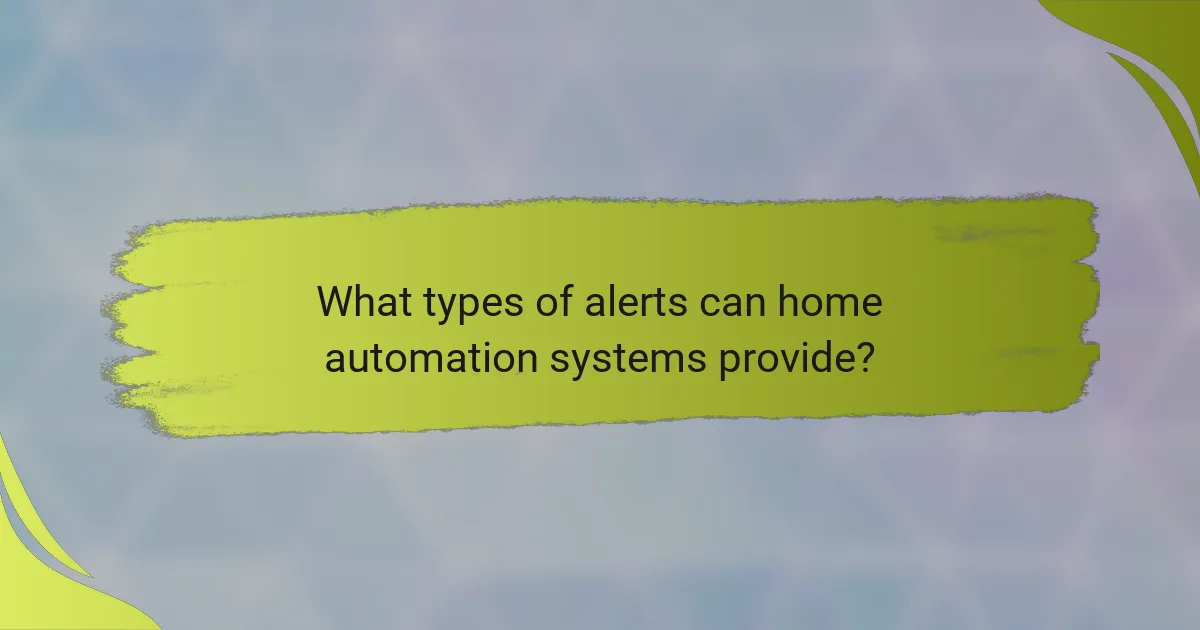
What types of alerts can home automation systems provide?
Home automation systems can deliver various alerts to enhance security and monitoring. These alerts typically include notifications for intrusion, environmental changes, and system status, helping homeowners stay informed about their property.
Intrusion alerts
Intrusion alerts notify homeowners when unauthorized access is detected, typically through motion sensors, door/window contacts, or security cameras. These alerts can be sent via smartphone notifications, emails, or audible alarms, ensuring immediate awareness of potential threats.
To maximize effectiveness, consider integrating your intrusion detection system with local law enforcement or a monitoring service. This can provide an added layer of security, as professionals can respond quickly to verified alerts.
Environmental alerts
Environmental alerts monitor conditions such as smoke, carbon monoxide, flooding, or extreme temperatures. These alerts are crucial for preventing damage and ensuring safety, as they can trigger alarms or notifications when hazardous conditions arise.
For example, a smart smoke detector can send an alert to your phone if smoke is detected, allowing you to take action even when you are away from home. Regularly test these systems to ensure they function correctly and replace batteries as needed.
System status alerts
System status alerts inform homeowners about the operational state of their home automation systems, including connectivity issues, low battery levels, or maintenance reminders. These alerts help ensure that all components are functioning properly and can prevent lapses in security.
To maintain optimal performance, set up notifications for system updates and regularly check the status of your devices. This proactive approach can help you avoid potential security gaps and ensure your home automation system operates smoothly.
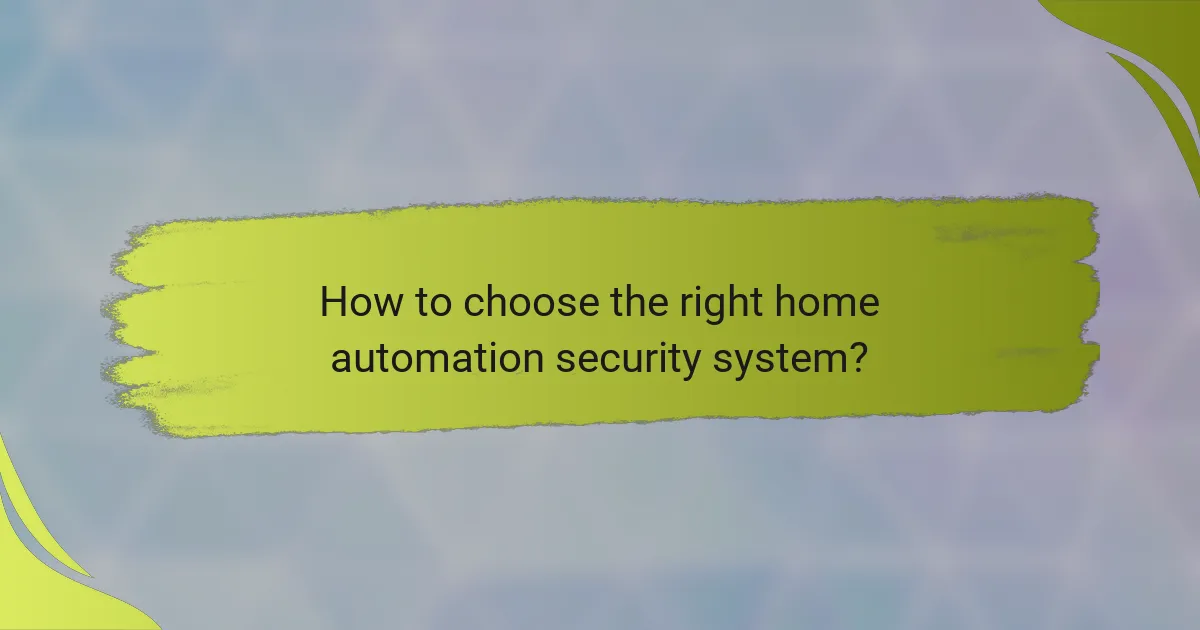
How to choose the right home automation security system?
Choosing the right home automation security system involves evaluating your specific security needs, budget, and compatibility with existing devices. A well-selected system enhances safety and provides peace of mind while fitting seamlessly into your home environment.
Assessing needs
Start by identifying the areas of your home that require monitoring and protection. Consider factors such as the size of your property, the number of entry points, and any specific vulnerabilities.
Think about the types of security features you want, such as cameras, motion detectors, or smart locks. Prioritize features based on your lifestyle and the level of security you desire.
Budget considerations
Establish a budget that accounts for both initial setup costs and ongoing expenses. Home automation security systems can range from a few hundred to several thousand dollars, depending on complexity and features.
Factor in potential monthly fees for monitoring services, which can vary widely. Aim for a balance between affordability and the level of security you need to ensure effective protection.
Compatibility with existing devices
Check if the security system is compatible with your current home automation devices, such as smart lights, thermostats, or voice assistants. Compatibility ensures seamless integration and enhances functionality.
Research systems that support popular communication protocols like Z-Wave or Zigbee, as these can often connect with a wider range of devices. This will help you avoid the hassle of replacing existing equipment.

What are the leading home automation brands in India?
The leading home automation brands in India include Amazon Alexa, Google Nest, Philips Hue, and TP-Link Kasa. These brands offer a variety of smart home devices that enhance security, monitoring, and alerts for homeowners.
Amazon Alexa
Amazon Alexa is a voice-controlled assistant that integrates with various smart home devices. It allows users to control security cameras, smart locks, and alarms through voice commands, providing convenience and ease of use.
When setting up Amazon Alexa, ensure compatibility with your existing devices. Many security systems and cameras are designed to work seamlessly with Alexa, allowing for real-time monitoring and alerts directly through voice prompts.
Google Nest
Google Nest offers a range of smart home products, including security cameras, doorbells, and smart thermostats. The Google Home app allows users to monitor their home security and receive alerts on their smartphones.
Consider the Nest Aware subscription for enhanced features like continuous video recording and intelligent alerts. This service can significantly improve your home security by providing more detailed monitoring options.
Philips Hue
Philips Hue specializes in smart lighting solutions that can enhance home security. By automating lighting schedules, users can simulate occupancy, deterring potential intruders.
Integrating Philips Hue with other smart home systems, such as Amazon Alexa or Google Nest, allows for coordinated security responses, like turning on lights when a security camera detects motion.
TP-Link Kasa
TP-Link Kasa offers a variety of smart plugs, cameras, and switches that help manage home security. Their devices can be controlled remotely via the Kasa Smart app, providing flexibility and peace of mind.
Utilize Kasa’s scheduling features to automate devices, such as turning on lights or cameras at specific times. This can enhance security by creating the appearance of an occupied home, especially when you are away.
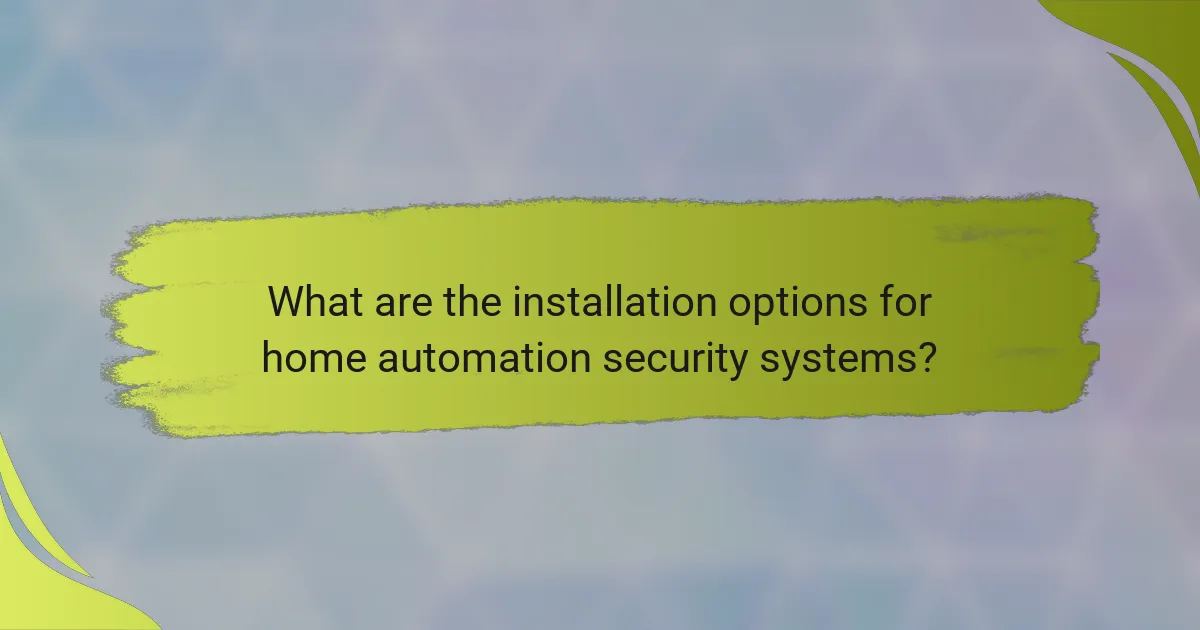
What are the installation options for home automation security systems?
Home automation security systems can be installed in various ways, depending on your needs and preferences. Options include DIY installations, professional installations, and hybrid solutions that combine both approaches.
DIY Installation
DIY installation allows homeowners to set up their security systems without professional help. This option is often more cost-effective, as it eliminates labor costs associated with hiring experts. Many systems come with user-friendly instructions and pre-configured components, making setup manageable for most individuals.
However, DIY installations require a certain level of technical comfort. It’s crucial to carefully follow the guidelines provided by the manufacturer to ensure the system functions correctly. Common pitfalls include improper placement of cameras or sensors, which can lead to blind spots in coverage.
Professional Installation
Professional installation involves hiring a technician to set up your home automation security system. This option typically ensures that the system is installed correctly and optimized for your specific environment. Professionals can assess your home’s layout and recommend the best placement for cameras, alarms, and sensors.
While this option is generally more expensive due to labor costs, it can save time and reduce the likelihood of errors. Additionally, many companies offer warranties or ongoing support for professionally installed systems, providing peace of mind.
Hybrid Solutions
Hybrid solutions combine elements of both DIY and professional installations. Homeowners may choose to install basic components themselves while hiring professionals for more complex elements, such as integrating smart home features or configuring advanced security settings.
This approach allows for flexibility and can be tailored to fit various budgets. It’s essential to communicate clearly with the technician about which components you plan to install yourself and which ones you would like assistance with to ensure a seamless integration.
